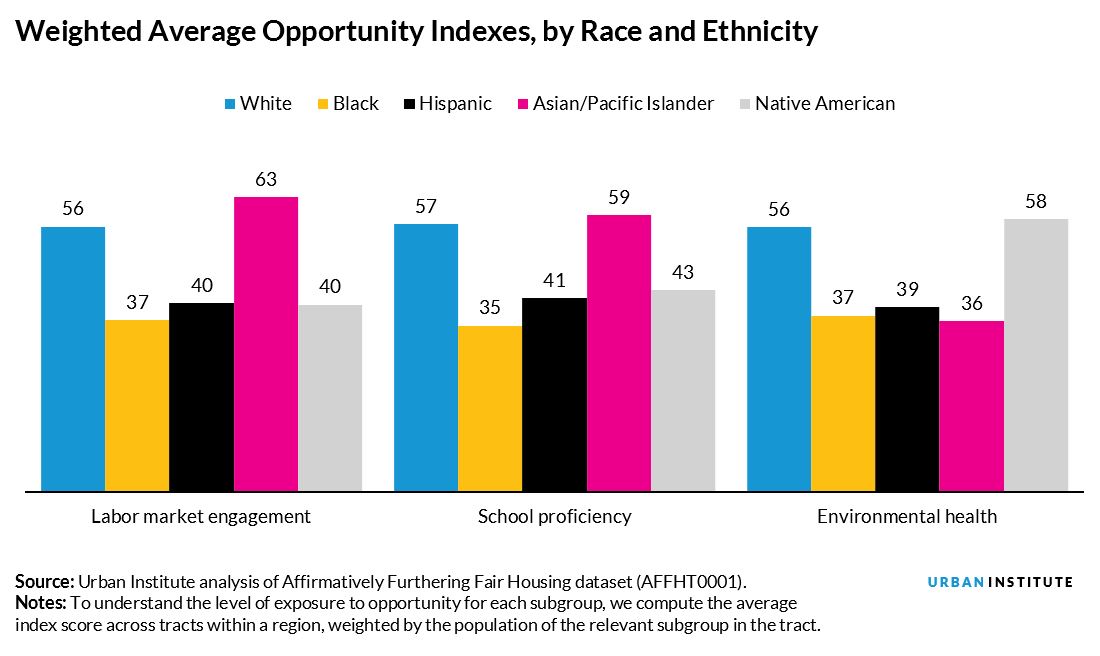
<p>The Bunker Hill housing complex in Boston's Charlestown neighborhood is pictured on May 16, 2017. Photo by Pat Greenhouse/The Boston Globe via Getty Images.</p>
Last month, civil rights groups filed a lawsuit against the US Department of Housing and Urban Development (HUD) for suspending the implementation of the Affirmatively Furthering Fair Housing (AFFH) rule.
The rule, adopted in 2015, interprets and enforces the federal Fair Housing Act’s requirement that every state and local government that receives federal housing and community development funding take affirmative steps to address racial segregation and remove barriers to housing choice. To help jurisdictions complete assessments of fair housing and racial segregation in their communities, HUD developed a dataset that includes information on access to opportunity.
Our recent report, which includes a national analysis of this dataset, highlights the unequal landscape of opportunity, affirming the need for programs like AFFH that explicitly aim to dismantle racial segregation and barriers to housing choice. Although HUD suspended the requirement that communities prepare and submit fair housing assessments, data show that the need for action addressing the legacy of housing discrimination is still strong.
Place and opportunity are inextricably linked
Where people live affects their well-being and ability to thrive. Previous research has demonstrated neighborhoods’ impact on residents’ social and economic mobility.
But not all neighborhoods provide their residents equal access to the opportunities necessary to succeed. White residents tend to have more access to high-opportunity neighborhoods than residents of color do.
This trend did not come about by chance. Programs, policies, and practices have systematically denied equal opportunity to people of color, resulting in segregated neighborhoods with unequal access to resources.
Although racial segregation has declined over the past decade, it persists. And research shows that racial segregation can limit access to opportunity for all residents, especially residents of color.
Neighborhood-level access to opportunity varies by race and ethnicity
Federal fair housing data used in the AFFH program reinforces the connections between place and opportunity for racial and ethnic groups. We analyzed HUD’s AFFH dataset to understand how neighborhood-level exposure to opportunities in jobs, housing, and health vary by race or ethnicity.
White and Asian or Pacific Islander households tend to live in neighborhoods with stronger labor markets and better-performing elementary schools compared with black, Hispanic, and Native American residents (see figure below).

Black, Hispanic, and Asian or Pacific Islander residents are more likely to be exposed to environmental toxins at the neighborhood level than white residents. These disparities persist across metropolitan and rural areas, but they are most pronounced in metropolitan regions (see figure below).

In addition to encouraging jurisdictions to look at disparities in access to opportunity by race or ethnicity, HUD created a tract-level designation as part of the AFFH rule to help jurisdictions identify racially and ethnically concentrated areas of poverty (R/ECAPs). A R/ECAP is a tract that is at least 50 percent nonwhite and has a poverty rate that exceeds 40 percent.
The AFFH data show large differences in the average exposure to opportunity between people living in R/ECAPs and those who live outside R/ECAP-designated tracts (see figure below). The difference in labor markets is most stark, and the school proficiency index shows children in R/ECAPs have less exposure to high-performing schools than do children who live elsewhere.

Policies and programs should address racial and ethnic disparities in access to opportunity
The federal dataset created to help jurisdictions address racial discrimination in housing and neighborhoods shows that racial disparities in access to opportunity persist, especially in metropolitan areas.
Despite HUD’s suspension of the AFFH rule, local actors continue to understand the importance of addressing the legacy of racial discrimination and segregation. Several jurisdictions have announced intentions to continue to use data from the AFFH rule as part of their fair housing planning processes. And other regional planning departments have implemented racial equity strategies.
By using the federal data from HUD and local data and knowledge to identify challenges and develop evidence-based solutions, jurisdictions can continue to improve racial equity.
Let’s build a future where everyone, everywhere has the opportunity and power to thrive
Urban is more determined than ever to partner with changemakers to unlock opportunities that give people across the country a fair shot at reaching their fullest potential. Invest in Urban to power this type of work.